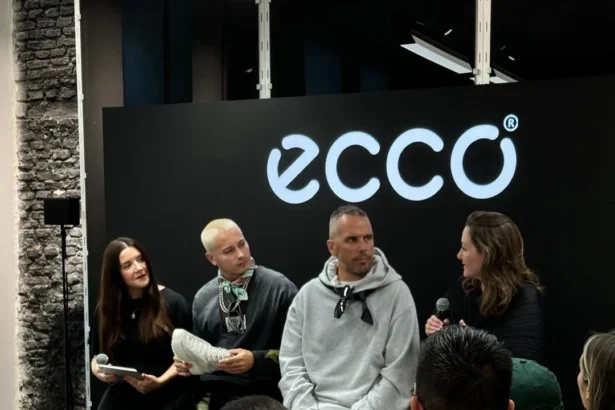In a groundbreaking move for sustainable fashion, OXMAN, the visionary design lab founded by Neri Oxman, has unveiled its latest innovation: a 100% biodegradable, 3D-printed shoe. This debut collection of footwear, created using the newly developed O° (pronounced “O-Zero”) platform, redefines the possibilities for eco-friendly, wearable products by integrating cutting-edge biomaterials with sustainable design principles. This revolutionary platform showcases the potential for minimal-waste production and environmentally responsible lifecycles, setting a new standard in the fashion and wearable tech industries.

A New Paradigm in Sustainable Production
At the core of OXMAN’s latest innovation is the O° platform, which pairs biomaterials with advanced digital and robotic manufacturing techniques. Rather than relying on traditional, resource-intensive materials like petrochemical-based plastics and adhesives, the O° shoes are constructed from polyhydroxyalkanoates (PHAs), a unique organic thermoplastic that is fully biodegradable. This visionary platform is an answer to growing concerns over the fashion industry’s environmental footprint, delivering products that decompose without leaving microplastics or toxic residues.
From Raw Biomaterial to 3D-Printed Shoe: How the O° Platform Works
The design and manufacturing of the O° shoes emphasize simplicity and sustainability. While conventional shoes can incorporate up to 40 different materials, including synthetic rubbers, plastics, and fabrics, O° shoes are made from a singular biomaterial. This streamlined approach not only reduces the complexity of recycling but also eliminates waste generated from multiple material sources. The entire process, from digital modeling to 3D printing, allows for a seamless, waste-free assembly under one roof.
OXMAN’s team developed their PHA material specifically to withstand the demands of wearable products. PHA is created through bacterial fermentation, making it a versatile and environmentally friendly alternative to conventional plastics. By leveraging methods like hot melt spinning, 3D knitting, and 3D printing, the O° platform transforms this organic material into a durable, flexible shoe that’s as functional as it is sustainable.
“One With the Environment”: The Circular Lifecycle of PHA Shoes
The unique properties of PHAs enable a circular lifecycle for the O° shoes. Unlike synthetic plastics, which often break down into microplastics that harm marine and terrestrial ecosystems, PHAs decompose back into their organic origins without any residual pollutants. As Oxman explains, the PHA material ultimately returns to the bacterial form from which it was derived, making it “one with the environment” in a closed-loop system.
This is a significant leap forward in sustainable design. PHAs have long been considered a promising alternative to petroleum-based plastics, and with O°, OXMAN has brought this potential to life in a practical, consumer-friendly product. Despite their degradability, the O° shoes are built to last and will not break down during wear, ensuring a reliable, high-quality experience for the user.
Reinventing Footwear Design with Human-Centric Data
OXMAN didn’t stop at material innovation. The O° shoes also feature a unique, performance-oriented design crafted from kinetic data that tracks human movement. This user-focused design approach ensures that each pair offers the support, flexibility, and durability necessary for everyday wear. The shoes comprise a knitted upper layer made from a 100% PHA yarn, developed in-house through hot melt spinning. This base layer provides a breathable and adaptive fit, tailored to support the foot’s natural motion.
The shoe’s exterior is reinforced with strategically placed 3D-printed layers, which deliver additional benefits such as cushioning, strength, and flexibility. This marriage of knitted and printed components allows OXMAN to dispense with the traditional cut-and-sew and adhesive techniques that dominate the footwear industry. Not only does this reduce the potential for waste, but it also lowers production costs and enables faster, more localized manufacturing.

Minimal Waste, Maximum Impact: The Benefits of Robotic Production
A pivotal aspect of the O° platform is its reliance on robotic manufacturing. By using advanced knitting and 3D printing systems, OXMAN has developed a near-zero waste production method. This automated, precision-controlled process drastically reduces the need for human intervention and can be conducted entirely in-house, minimizing transportation costs and the environmental burden of long-distance supply chains.
The manufacturing process also highlights the flexibility of the O° platform, which can adapt to different products and styles while maintaining its sustainability credentials. OXMAN’s emphasis on localized production could help decentralize the traditionally globalized fashion industry, where distant supply chains contribute to high carbon emissions and logistical challenges.
A Vision for the Future: Scaling the O° Platform
As consumer interest in sustainable and ethically sourced products grows, OXMAN’s O° platform represents a timely and impactful solution. The design lab is currently exploring partnerships and investments to scale the platform, which could open the door for biodegradable textiles and wearable products to enter the mainstream market. This expansion holds the promise of transforming the fashion industry’s approach to materials and production, setting an inspiring precedent for future sustainable innovations.
Conclusion: Pioneering a New Chapter in Sustainable Fashion
OXMAN’s O° platform and its first collection of biodegradable, 3D-printed shoes are more than just a product—they are a paradigm shift. By combining the biodegradable properties of PHA with robotic production methods, OXMAN has created a wearable that is both functional and sustainable, offering a glimpse into a future where design and environmental responsibility go hand in hand. As the platform scales, it may well redefine not only the shoe industry but also the larger realm of wearable products, challenging designers and manufacturers to prioritize sustainability at every stage of production.
FAQs
- What makes the O° shoes fully biodegradable?
The O° shoes are made from polyhydroxyalkanoates (PHAs), an organic material derived from bacterial processes. PHAs are known for their ability to break down without leaving microplastics or toxic residues, which ensures the shoes biodegrade fully after disposal. - Will the shoes break down while being worn?
No, the shoes are designed to be durable during wear. The biodegradable properties only activate under specific composting conditions, ensuring they remain intact as long as you need them. - How does robotic manufacturing contribute to sustainability?
Robotic manufacturing enables precise, minimal-waste production by eliminating the need for cutting and sewing and reducing excess material use. It also reduces human intervention and can be localized, cutting down on emissions from shipping. - What is PHA, and why is it significant in sustainable design?
PHA is an organic thermoplastic created from bacterial fermentation. It decomposes back into bacteria in natural conditions, leaving no microplastics. This material’s unique properties make it an eco-friendly substitute for petroleum-based plastics. - Are there plans to expand beyond footwear?
Yes, OXMAN is looking to scale the O° platform to produce other biodegradable textiles and wearable products, potentially extending sustainable design to a wide range of fashion and technology products.




